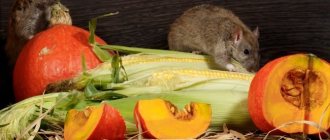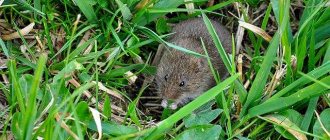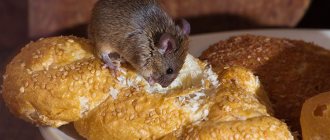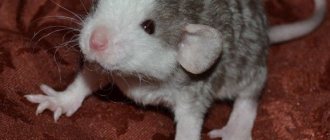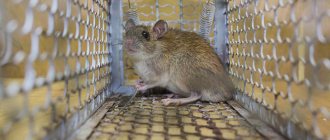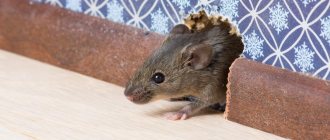A little history
Who knows where this myth came from.
Most likely, the traces lead to the Middle Ages. Before the invention of the refrigerator, storing food was much more difficult, so everyone got out of the situation as best they could: meat was attached to a hook under the ceiling, grain was kept in bags or barrels, and large circles of cheese were covered with wax or wrapped in linen. In those days, a hungry mouse agreed to eat anything.
Meat hanging from the ceiling was harder to get, wheat or cheese was much easier to access. But the loss of several grains from the bag is not so noticeable, and teeth marks are treacherously visible on a piece of cheese. This may have led many to believe that mice love cheese. Even if in fact they only eat it because it turned out to be their only prey.
Favorite characters
According to another version, perhaps this image was simply well played out by animators and caricaturists who were able to perpetuate this myth for many years. Today it is much easier to imagine and draw a mouse with a delicious slice of cheddar than with a crust of bread and a few grains of rice.
The creators of the popular animated series “Chip 'n' Dale Rescue Rangers” went even further. One of the rescuers is named Rocky, and his full name is Roquefort - in honor of the famous cheese. His father is Charlie Cheder and his mother is Katie Camembert. The main weakness of this daredevil is his incredible love for cheese; from the mere smell he falls into a trance and tries with all his might to get to the coveted piece. But the author’s idea hardly has any connection with reality. Rather, it is a fiction, nothing more.
What other fairy tales exist about this?
The next version of mice’s pseudo-love for cheese lies in the shortage of food in the homes of medieval residents.
Like, in those days there was tension with food
. She was sorely missed. There were minimal supplies in the house. As a result, it was difficult to establish the fact that mice were eating food.
Only teeth marks on the cheese served as clear evidence of the presence of mice in the house. This is what this version is based on, explaining the love of mice for cheese.
The next point is related to cartoons. The stereotype of a mouse with a slice of cheese was perpetuated by cartoonists. The rodent looked much better this way
than with some kind of grain.
Scientists' answer
Scientists from the UK were interested in the question of why mice love cheese. They conducted a number of experiments with mammals.
Experience has shown that mice prefer to eat plant foods, and they do not like the smell of cheese at all. Particularly odorous varieties evoke a feeling of danger, and they try to avoid the suspicious object.
An animal living in the wild will eat cereals and fruits, and will only eat other food in case of severe hunger. In the forest or in the field you will not find products created by man. Therefore, it is not surprising that the mammal loves natural food. It looks and smells safe.
Scientists from the British organization Pest Control UK became interested in the results of their colleagues and conducted their own experiment. They used traps with various baits:
- cheese;
- apple;
- chocolate.
The results showed that mice eat cheese. The trap was set with this delicacy, and they liked to run into it the most. But chocolate did not arouse any interest among the animals.
It is likely that the experiment involved different species of mice and different types of treats, which is why the results are so different from each other.
On a note!
Exterminators assure that you should take sunflower seeds, flour, wheat, and unrefined oil as bait. Pests love this kind of food more.
Mice's relationship with cheese
The question of why mice love cheese puzzles many. As scientific research has shown, gray thieves prefer plant foods: most of all, root vegetables of various plants and cereals rich in sugars. But in reality they are not at all interested in cheese, because in natural conditions they would never encounter such a product.
But experts were able to establish that mice do indeed respond to the cheese aroma. However, it is the pungent odor that causes this behavior. Mammals do not experience any taste preferences for products of this composition.
However, this fact applies to individuals capable of independently obtaining food for themselves. A hungry animal may like a delicacy loved by many people no less, since in a state of hunger the animal usually does not neglect anything. It was this hypothesis that scientists settled on.
Where did the statement come from?
Adults are sure that the myth was spread by animators and illustrators of children's publications. But even in ancient times, people believed that small animals love to dine on this aromatic delicacy.
Previously, when there were no poisons and chemicals, the fight against mice consisted of keeping all supplies safely hidden in jugs and cabinets. The exception was cheese. It should have been left uncovered to mature. So the mice had to gnaw it out of hunger.
Animators made the image of an animal with a fragrant treat in its paws very popular. Now many are sure that mice really love cheese.
The main diet of rodents is sweet fruits and cereals. In nature, they build nests in fields where they can easily get grain. The pest's sensitive nose does not tolerate strong aromas and artificial products. Mice do not like cheese and will choose other foods over it if given a choice.
Homemade diet
If you choose a mouse as a pet, keep in mind that you should not feed it cheese; it is harmful to its health, since it is not a rodent's usual food. Be sure to include fresh fruits and vegetables in your mouse’s diet, buy high-quality food, and some sweets and grains as a favorite treat from time to time.
After all, it has long been known that food should be not only healthy, but also tasty. Well, mice know a lot about food.
Children's cartoons and books depict a little girl with a piece of cheese in her paws. The animal is ready to do anything for the sake of a fragrant product. But do mice eat cheese in real life? This is the question that apartment and house owners ask themselves when they set bait in a trap.
What mice eat at home and in nature
If you have decided to keep a rodent at home, then in addition to the integral details that ensure a comfortable life for your pet and care for it, it is important to know how to create an impeccable menu. Food should be tasty and include all the necessary vitamins
The easiest way, for example, is to use ready-made balanced industrial food specifically for mice. However, some are worried about quality and cook their own food. The nutritional composition is entirely determined by what small animals usually eat in natural conditions.
It can be:
- grains: barley, wheat, rye, oats;
- nuts and seeds: peanuts, hazelnuts, walnuts, sunflowers;
- fruits and vegetables: zucchini, carrots, pumpkin, cucumbers, bananas, apples;
- greens: dill, parsley, grain sprouts.
What do bats eat at home and who eats them in the wild?
Most people have no idea what to feed in the apartment; some even consider them vampires. In fact, there are several categories, each of which has its own feeding characteristics (insectivores, carnivores, sunbirds and others).
Those who keep an animal at home should find out what it was fed with in the wild. Based on this, select the necessary products.
Many bats prefer condensed milk diluted with water. Carnivores have an animal instinct; they love finely chopped meat, offal, and insects (worms, cockroaches). Other species require feeding with a variety of fruits, including bananas. They prefer milk and fresh water to drink.
In nature, bats have many dangerous enemies. Considering them as food, nocturnal birds of prey (kestrel, eagle owl), marten, ferret, ermine, weasel, and wild cats are able to hunt the animals. Sometimes even forest mice and rats do not allow them to live, making their way inside the shelter in winter, and do not disdain their relatives.
Do mice eat tomatoes?
Rodents hibernating inside a greenhouse pose a particular danger to those who breed tomato seedlings. In summer it’s hearty outside, but when it’s cold, you can taste young shoots of plants and ripening fruits. Pests feed only on cotyledons; if the remaining sprouts are sprinkled with ash, they will not be touched.
There are people who are not embarrassed by such a neighborhood. They specially plant seedlings with reserves for little gray animals. And holes and passages in the floor are regarded as good natural ventilation for their greenhouse.
What do field mice eat?
The vole can often be found in nature in meadows, forests, and steppes. Its nutrition, first of all, depends on its habitat.
It can be:
- herbs, their bulbs, plant roots;
- insects, larvae;
- seeds, cereals;
- tree bark, leaves, buds, cones;
- mushrooms, nuts, berries.
People have been debating whether mice eat cheese for a long time. A group of English scientists decided to verify this fact or refute it several years ago. You will learn about how the experiments ended and whether rodents really eat cheese in this article.
Feeding mice at home
In nature, mice feed mostly on seeds, to which animal food is sometimes added. And therefore, at home, they need to be provided with a diet determined by nature.
- Grains are the first thing mice eat. Give the crumbs grains of wheat, oats, barley.
- Seeds – no more than 2-3 pcs. in a day.
- Protein products. Mice will benefit from a small amount of boiled or raw quail eggs, boiled (without salt) chicken, peeled boiled shrimp (no more than once a week, without spices), gammarus (dried freshwater crustaceans, which can be found in fish food departments).
- Vegetables. Carrots are especially useful. But you can also give zucchini, cucumbers, sweet peppers, cauliflower and Jerusalem artichoke, pumpkin.
- Fruit (sometimes as a treat). Apples, pears, apricots and peaches, melons, grapes, bananas are suitable. Among the berries you can give currants, strawberries, strawberries.
- Nuts. Hazelnuts, walnuts, peanuts (no more than 1 nut per day).
- Greens (in small quantities). Parsley, lettuce, cilantro.
- Bread (preferably black). It can be given, but very rarely.
- Cheese. Mice love it very much, but this product is harmful to them (it causes obesity and negatively affects the liver). Therefore, it can only be offered to pets as a rare treat.
- Water. It should always be freely available, in the required quantity (at least 25 grams per day), clean, fresh.
In addition, the mice need to be given twigs - they will help the rodents grind their teeth. It is better to choose branches of rowan, apple, hazel or willow. Branches of coniferous trees (spruce, pine) are also a source of vitamin C.
When choosing vitamins, you need to rely on qualified professional mixtures, since you will not be able to choose everything you need for your pet and in the right quantity.
Amount of food
As for the size of portions, it would be reasonable to calculate the amount of food based on the weight of the animal. For a mouse, one serving should be at least 1/5 of its weight. Rodents have excellent metabolism, and therefore they can afford to eat a lot.
Homemade mixtures for mice
Composing a diet for a small animal depends entirely on what mice eat in nature. Since this is a detachment of rodents, they will mainly eat plant foods:
- grain crops such as wheat, barley, rye, some oats, etc.;
- plant seeds and nuts, for example, sunflower, walnuts, peanuts, hazelnuts, but there should not be too many of them: excess plant protein will lead to obesity and liver problems;
- vegetables and fruits - which ones to give will depend on what the mice like most, but you should offer all kinds: carrots, zucchini, cucumbers, pumpkin, apples, bananas;
- green parts of plants: parsley, dill, sprouted grains - they contain a lot of carotene and vitamin C.
Brown bread and dried fruits (raisins, prunes) are used as delicacies. It’s worth answering a fairly common question right away: do mice eat cheese? They eat it with great pleasure, but in large quantities the dairy product provokes liver problems, leading to obesity.
Feeding rules
A mouse needs to eat enough food per day so that its weight is approximately one-fifth of the rodent’s live weight.
On average, an adult animal needs one teaspoon of grain mixture per day. There is a small “but”: food should always be in the cage. The fact is that mice eat every two to three hours due to their rapid metabolism. If the rule is ignored, the pet may develop health problems.
Be sure to put branches of fruit or wild trees and shrubs in the cage so that the rodents have the opportunity to grind down their teeth.
The food pyramid for mice looks something like this:
- proteins 14%,
- fats 10%,
- fiber 9%.
With any type of feeding, protein foods of animal origin must be offered once a week. This can be a boiled egg, boiled white chicken meat, freshwater crustaceans, fermented milk products, insects, etc.
Weakened animals, pregnant females, and babies can and should be given baby food. It will be especially useful if you are intolerant to natural milk.
Don't forget about vitamins and minerals. The first ones are given with food or dissolved in water.
Mineral supplements are sold in the form of figurines; mice love to chew on them.
You should never feed mice table scraps: any salty, sweet, smoked, fried, hot, spicy food is deadly for your pet. Even if human food does not destroy the tiny animal instantly, it will certainly lead to a faster death than is measured by nature.
Other harmful products:
- milk, many pets have intolerance,
- potatoes and their peelings,
- food for cats and dogs, although some owners note that mice love it,
- beet,
- tomatoes,
- cabbage,
- citruses,
- You should also not eat the green parts of potent medicinal herbs, especially those that are bitter: celandine, wormwood, gentian, etc.
Fresh water should always be in the cage.
It is better to use nipple drinkers, so the liquid will always remain clean. During transportation, you can use ordinary wet cotton wool as drinking bowls; the animals will suck water out of it and will definitely not die of thirst during the journey.
Is yogurt good for rodents?
Sometimes kefir can be replaced with yogurt. Yogurt must be natural and free of flavors, sugar and preservatives.
Sweet yoghurts with pieces of fruit or berries are not suitable as a treat for rats, as they contain many harmful additives and dyes.
Do not forget that a domestic decorative rat, unlike its wild relatives, can get sick and even die if fed incorrectly. Therefore, your pet’s daily diet should be balanced and consist of healthy grains and vegetables. It is impossible to often pamper a rodent with dairy products and other delicacies, because they are a supplement to their diet, and not the main food. Nutrition Read more Is milk healthy in the diet of rats?
Milk is rich in vitamins A, D, and E. The high calcium content also makes this product healthy. But your tailed pet does not need milk in the daily menu. It (in large quantities) can contribute to digestive upset and, as a result, cause diarrhea. There should be fresh drinking water in the drinking bowl every day, but milk is already a complete food.
You can offer milk to your pet rats no more than 2-3 times a week.
Remember one rule. A rat can only eat what a rodent could find in a field!
I’m not telling you my own thoughts. This is a direct message from the veterinarian from the Cobra clinic.
– Anyone who keeps rodents should be familiar with this veterinary clinic. This phrase was then repeated to me by all the doctors we encountered in our lives.
This means no food from the table.
, bread (!!!) and crackers, no processed or processed foods.
Only grain, specialized food and non-sweet, non-fatty fruits.
Bananas, watermelons and melons
should not rats They're just too sweet. Also forget
about fried and salted nuts.
Rats can be treated to
raw walnuts (once a week), or a small handful of pumpkin seeds, also raw (once a week).
Let me remind you about milk. They can't
no sour cream, no cottage cheese (even low-fat!), cheese.
milk, all kinds of curds, yoghurts and ice cream, and especially butter. Also, of course, forget
about chocolate, sweets and other sweets.
it’s not worth talking about the fact that rats shouldn’t
When getting an animal, first of all you must take care of its health! Conscious improper feeding of an animal is akin to animal husbandry - you will deliberately spoil the animal’s health, and therefore its duration and quality of life!
A piece of green apple is a great treat for an animal! But no more than a couple times a week.
If you want to treat the animal
, use special sticks with grains, biscuits for rodents, a small piece of an apple or a juicy vegetable that is not red, the color red usually means. that the product is a strong allergen. a piece of carrot, cabbage. The only exceptions are a boiled egg white or a very small piece of well-cooked chicken breast. Good sources of protein, but should not be abused. Once a week will be more than enough.
Don't love your pet...to death!) All the best).
Cottage cheese is a treat for rats
You can diversify your pet's diet with fresh cottage cheese. Give animals cottage cheese once every two weeks, without adding salt or sugar to it.
Cottage cheese is especially useful for pregnant females and nursing mothers, as it promotes milk production and significantly improves its quality.
How to prepare milk for rats?
In order for milk to benefit your pet and not harm its health, you need to boil this drink and cool it to room temperature. You should not give rats either cold or hot drinks, as this leads to gastric upsets.
Which milk is best for the diet?
Cow's milk is considered the most optimal for inclusion in the diet of rats. It is more balanced in fat content than sheep or goat.
Sour cream in the diet of rodents
Sour cream is not a very suitable product for feeding rodents, because it does not contain any vitamins and microelements that are beneficial to the health of the animal. Therefore, it is undesirable to include it in the menu of tailed pets, especially for homemade sour cream and heavy cream, which are extremely harmful to the liver of animals.
What kind of milk is absolutely forbidden for rodents?
There are types of milk that should not be consumed by your pet as they may be harmful to them. These types of milk include:
- Soy milk, as it causes increased gas formation and bloating in your pets;
- Coconut milk. This exotic thing for our area can cause allergic reactions in your rat;
- Condensed milk is also prohibited. It contains a large amount of sugar, which is harmful to the well-being of tailed animals;
Drinks made from milk powder are also harmful to your pets.
Important! Some rats have their own individual characteristics and cannot tolerate lactose, which is found in milk. Remember to be careful when offering your pet a milk drink in small portions for the first time. Monitor his behavior, see if there are any allergic reactions to this dairy product.
Can rats eat cheese?
The question of whether rats eat cheese does not raise doubts among many people, because there is an established stereotype that this product is a favorite delicacy for rodents. In fact, the animals really love cheese and will never refuse a piece of this delicacy. But it is not recommended to often give cheese to rats, since due to its excessive consumption, animals develop obesity.
Hard cheese contains a lot of salt and fat, so you should pamper your small pet with this treat no more than once a week.
In addition, not all types of cheese are suitable for feeding rodents and some of them can provoke both an allergic reaction and cause food poisoning.
Prohibited types of cheese:
- Suluguni;
- cheese or feta;
- smoked cheeses;
- processed cheese;
- products with a high percentage of fat content;
- blue cheeses.
Important: cheese should not be given to decorative rats if the animal suffers from stomach upsets or problems with the liver and kidneys.
Should you give your pets kefir?
Kefir improves digestion and is easily absorbed by the body of rodents, therefore it is a useful product for tailed pets. But it must be remembered that animals should be fed only low-fat and non-sour kefir. Also, it is strictly forbidden to give animals stale or processed fermented milk products.
Cheese in the diet of rats
Surely in their dreams, rats eat cheese every day. This product is a real delicacy for pets. Keeping rodents confirms this fact. But, like many dairy derivatives, its excessive consumption causes obesity.
Giving rats cheese is allowed once every 5-7 days. More often it is not worth it, since a lot of salt in the composition will not do any good.
Certain types of cheese provoke poisoning and allergies. These include:
- Suluguni;
- cheese and feta;
- smoked varieties;
- processed cheeses;
- moldy products.
Rats should not eat cheese with high fat content, especially for animals with liver, kidney or gastrointestinal problems.
Conclusion
Mice are vegetarians. They will eat seeds, vegetables and fruits faster than cheese. But this does not mean that mice will ignore the product in question. If there is nothing suitable, these rodents will eat anything, including cheese.
Sources
- https://FB.ru/post/nature/2018/6/19/27023
- https://zen.yandex.com/media/factusios/myshi-i-syr-pravda-li-chto-pervye-tak-liubiat-vtoroe-ili-eto-vrane-5e24a5eb32335400ac8d97ac
- https://apest.ru/myshi/vse-o-myshah/edyat-li-myshi-syr/
- https://klause.ru/gryzuny/lyubyat-li-myshi-syr.html
- https://KOTiKo.ru/krysy/pitanie-krys/mozhno-li-krysam-syr-moloko-tvorog-i-drugie-molochnye-produkty.html
- https://likehamster.ru/domashnie-krysy/pitanie-krys/molochnye-produkty-krysam/
- https://zen.yandex.ru/media/id/5ca4d38ad92e0900b447a942/chem-mojno-kormit-krysu-a-ot-chego-luchshe-otkazatsia-5ce80e1fb2297700b54b7f45
- https://homkin.ru/krysy/pitanie-krys/mozhno-li-krysam-syr-i-moloko.html
[collapse]
Which is strictly prohibited?
Above we got acquainted with milk, which is allowed to be included in the diet, and below are the types prohibited for consumption:
- Soy. Its use will lead to disorders, gas formation, and bloating.
- Coconut. It is an allergen and in most cases causes the development of severe allergies.
- Condensed. Rodents are prohibited from foods containing sugar; milk also contains a very high sugar content, which will certainly affect their well-being and health.
- Dry. Drinks made from such a product will not bring anything good, but they can cause harm.
Owners of decorative rats need to remember that despite the permits and prohibitions of a particular product, the animal may have allergic reactions to some food or other, and may also have lactose intolerance. New foods should be introduced as carefully as possible. Start with very small portions and be sure to monitor how you feel after that.

